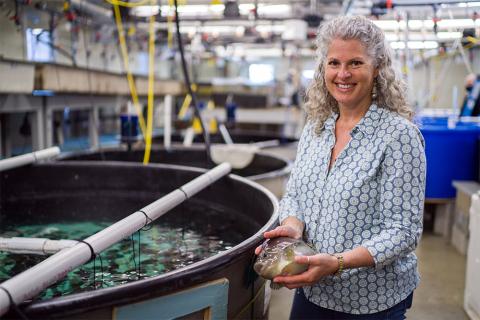
About the Research
The University of New Hampshire has been working with the New England aquaculture industry (salmon farmers in Maine and steelhead trout farmers in N.H.) to promote the use of cleaner fish in salmonid cage culture to control parasitic sea lice. The sea lice graze on the skin and mucosal tissue of the fish, leaving them open to secondary infections, as well as decreasing their value upon harvest and processing. The result is sea lice mitigation is the single largest and costly issue facing the global salmonid aquaculture industry today.
Historically, farms treated their fish with chemotherapeutics, but sea lice have grown resistant to such drugs and, additionally, this practice is not environmentally friendly. Currently, fish farms use a variety of tools to combat sea lice infestation, but the most promising tool being used in Canada and Europe is stocking cleaner fish in cages to keep sea lice populations under control. Lumpfish (Cyclopterus lumpus), a species native to the Gulf of Maine, is an effective “biological delouser” and currently there is an industry-driven request for lumpfish hatcheries in the U.S. to satisfy their cleaner fish needs. The Fairchild Lab at UNH has been successfully rearing lumpfish for cleaner fish studies since 2019 and assessing their effectiveness on steelhead trout, while working closely to address industry needs.
About the Researcher

Elizabeth Fairchild
Research Associate Professor, Biological Sciences
Elizabeth.Fairchild@unh.edu; 603-862-4475
» View all Aquaculture Researcher spotlights
» View all COLSA Student Aquaculture Researcher spotlights
Check out COLSA student research spotlights:
About the Fairchild Lab
The Fairchild Lab at UNH promotes sustainable, environmentally friendly methods by using a biological control (lumpfish) instead of a physiological control (chemotherapeutics) to curb sea lice infestation. This research is helping to facilitate development of the first commercial U.S. lumpfish hatchery, which greatly increases the chances of expanding salmonid ocean farms in Maine and New Hampshire, leading to greater volume and a higher economic yield of locally and sustainably grown seafood in New England. With more salmonid farms in use, the U.S. seafood deficit could decrease if domestic salmonid production increases and foreign imports of farm raised salmonids decrease.
Research foci include:
- Improving lumpfish hatchery production methods (fish nutrition and feeding studies, behavioral studies, evaluating hatchery stressors, husbandry and reproductive studies, and minimizing fish aggression),
- Farm techniques (lumpfish – steelhead trout experimental cage studies, effects of currents on lumpfish in the farm, fish welfare), and
- Field studies (understanding wild lumpfish population dynamics).

Juvenile lumpfish in a tank.
Key Findings
Some key findings from the Fairchild Lab include:
- As far as coldwater marine fish, lumpfish are easy to raise!
- If lumpfish are present in steelhead trout cages, sea lice loads (amount of sea lice on the trout) are lower.
- Juvenile lumpfish can be reared at much higher densities than originally thought without affecting fish survival. Fish survival did not differ between 40 to 90g/L. (The industry standard reportedly is 40 g/L.)
- In the hatchery, juvenile lumpfish growth can be manipulated to match the seasonal salmonid farm needs for cleaner-fish since lumpfish will outgrow their usefulness as sea lice consumers. Lumpfish growth can be sped up by reducing stocking density (the number of fish in a rearing tank) and feeding them high protein diets. Conversely, by increasing stocking density and/or feeding lumpfish diets low in protein or formulated for salmonids, lumpfish growth can be depressed.
- Tank color does not seem to affect lumpfish growth, survival, or aggression. For ease of tank cleaning for young juvenile lumpfish, dark walled tanks with light bottoms or false bottoms resulted in reduced cleaning time as the fish tended to adhere to the dark tank walls than the tank bottoms.

Big Picture
While there is a U.S. Atlantic salmon industry, it does not meet market demands. Americans love farm raised Atlantic salmon: the U.S. imports more Atlantic salmon than any other finfish, and salmon imports, valued at over $4 billion, exceed all other imported seafood products except shrimp (USDA 2017; NOAA 2018).
UNH is the only U.S. group that has consistently reared lumpfish each year since 2019 for cleaner fish studies. Juvenile lumpfish production has ranged from 5,000 to 20,000 fish per year. UNH is also a founding member of the U.S. Lumpfish Consortium, an informal group consisting of researchers from UNH, USDA, UMaine, Cooke Aquaculture (both U.S. and Canadian groups), Blue Water Fisheries LLC, Kennebec River Biosciences, and Memorial University of Newfoundland. The group is open to any persons or groups interested in promoting research on the culture and use of lumpfish in US aquaculture.
Collaborators
- Memorial University of Newfoundland (Danny Boyce)
- UMaine Center for Cooperative Aquaculture Research (Steve Eddy)
- UMaine (Heather Hamlin, Michael Habte-Tsion, Matt Hawkyard)
- USDA National Cold Water Marine Aquaculture Center (Brian Peterson, Mike Pietrak, Gary Burr)
- NH Sea Grant (Michael Chambers, Mike Doherty, Eric Berghahn, Tim Briggs)
- Cooke Aquaculture (Andrew Swanson, Greg Lambert, Geoffrey McBriarty)
- Blue Water Fisheries LLC (Scott Flood)
- UNH Cooperative Extension (Shane Bradt)
- UNH Biological Sciences Department (Easton White)

This project recieved funding support from the New Hampshire Agricultural Experiment Station at UNH!
Funding
- NH Agricultural Experiment Station Hatch 1026188 (NH00704)
- Northeastern Regional Aquaculture Center
- New Hampshire Sea Grant
- NOAA Fisheries Saltonstall-Kennedy Program
Related Published Works
- Doherty, M. B. (2021). The Presence of Sea Lice on Steelhead Trout at a Marine Farm in NH Waters and the Utilization of Lumpfish as a Biological Delouser. Master's Theses and Capstones. 1504.
- Spada, N. (2022). Improving Larval and Juvenile Lumpfish, Cyclopterus lumpus, Aquaculture: Nutrition and Growing Conditions. Master's Theses and Capstones. 1575.
- Fairchild, E. A., Pietrak M. R. , & Burr G. S. (2021). Lumpfish Hatchery Handbook. Northeastern Regional Aquaculture Center. Publication #301-2021. Maryland, 49 pages.
Additional Information & Resources
UNH Today articles:
